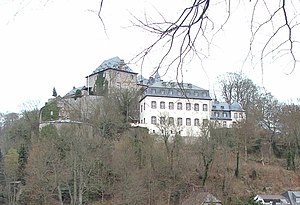Blankenheim Castle
| Blankenheim Castle | |
|---|---|
|
Blankenheim Castle from the south |
|
| Creation time : | around 1115 |
| Castle type : | Hilltop castle |
| Conservation status: | Preserved essential parts |
| Standing position : | Count |
| Place: | Blankenheim |
| Geographical location | 50 ° 26 '16.3 " N , 6 ° 39' 6" E |
The Blankenheim Castle is a castle above the town of Blankenheim in the Eifel . It was built as a hilltop castle around 1115 by Gerhard I and was the ancestral seat of the von Blankenheim family.
history
The Lords of Blankenheim were raised to the rank of count in 1380. After the death of the last ruling Count of Blankenheim from the Loon-Heinsberg family , Wilhelm II, Dietrich III, Count von Manderscheid , inherited the County of Blankenheim and the rule Schleiden as well as Gerhardstein ( Gerolstein ) in 1468 and called himself from 1469 Count of Manderscheid and Blankenheim. He divided his property between his three sons in 1488, with the second son, Count Johann, inheriting the County of Blankenheim, Jünkerath , Gerolstein Castle and parts of the Mechernich rule and establishing the Manderscheid-Blankenheim-Gerolstein line.
The Manderscheid-Blankenheim (-Gerolstein) line is often found in top spiritual positions in the Old Kingdom: Johann Moritz Gustav von Manderscheid-Blankenheim was Archbishop of Prague , Johann IV. Von Manderscheid-Blankenheim Bishop of Strasbourg; Elisabeth von Manderscheid-Blankenheim-Gerolstein, Clara Elisabeth von Manderscheid-Blankenheim , Margarete Elisabeth von Manderscheid-Blankenheim and Anna Salome von Manderscheid-Blankenheim were princess abbesses of Essen . Furthermore, there are Cologne canons and cathedral deacons, such as B. Philipp Salentin from Manderscheid-Blankenheim-Gerolstein .
In 1783, Karoline von Manderscheid-Blankenheim became Princess of Liechtenstein . With Maria Franziska, Manderscheid-Kail fell to Manderscheid-Blankenheim in 1742. But as early as 1780, after the male line of the Counts of Manderscheid-Blankenheim died out, the property fell to the Bohemian Count Philipp Christian von Sternberg , who had married Augusta von Manderscheid-Blankenheim in 1762 and was now called Sternberg-Manderscheid .
Revolutionary troops occupied the Left Bank of the Rhine and the Eifel in the French era in 1794 , Countess Augusta fled to her husband's homeland in Bohemia. Two cars filled with documents and proof of ownership were carried along. The Countess later tried to sue for her property in the Eifel from Prague , but this attempt failed. For the loss of the Blankenheim, Jünkerath, Gerolstein and Dollendorf areas on the left bank of the Rhine to France, the Counts of Sternberg-Manderscheid were compensated by the Upper Swabian Abbeys of Schussenried and Weissenau in the Reichsdeputationshauptschluss 1803 . In 1806 these were mediatized and came to the Kingdom of Württemberg . In 1835, with Johann Wilhelm (* 1765), secularized canon of Passau and Regensburg, the Sternberg-Manderscheid line in the male line expired. The two monastery estates were sold by the descendants to the Württemberg royal house in 1835.
investment
The complex was rebuilt many times, and over time a baroque castle with a baroque garden and an orangery was created from a medieval fortification . The end came in September 1794 when French troops marched into Blankenheim. Countess Augusta von Manderscheid-Blankenheim fled to Bohemia with her family .
The castle remained uninhabited for a long time and in 1894 Prussia began with security measures, while the late Baroque office building of the lower castle, built in 1786, came into private ownership (Vüllers family). In 1926 the German Gymnastics Association took over the castle and in 1936 the property became the property of the German Youth Hostel Association . This converted the castle into a youth hostel.
In its early days, the castle was dependent on rainwater collected in cisterns or water brought in. Therefore, Count Dietrich III. von Manderscheid-Blankenheim in 1469 dig a tunnel through the ridge called the zoo . The water from the “In der Rhenn” spring flowed through this in an approximately one kilometer-long dike line to the castle. This zoo tunnel was rediscovered in 1996.
Personalities
The lawyer and Catholic politician Moritz Lieber was born on October 1, 1790 at Blankenheim Castle.
literature
- Friedrich Toepfer: Supplements IX. The Lords of Blankenheim . In: ders. (Ed.): Document book for the history of the royal and baronial house of the Voegte von Hunolstein , vol. I. Jacob Zeiser, Nuremberg 1866, pp. 320–329 ( Google Books )
Web links
- Entry by Hans-Jürgen Greggersen zu Blankenheim in the scientific database " EBIDAT " of the European Castle Institute
- Entry on Blankenheim in the private database "Alle Burgen".
- Blankenheim. Portrait. DJH Service Center Rhineland (Youth Hostel)
- Blankenheim Castle. www.eifel.de
- The zoo in Blankenheim. The castle.
- Zoo tunnel in Blankenheim. Still water in the deep. North Rhine-Westphalia Foundation for Nature Conservation, Heritage and Culture


